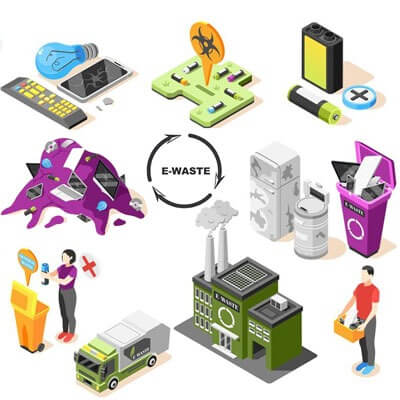

E-waste management is a comprehensive approach to dealing with electronic waste, which encompasses the responsible and sustainable handling of old or discarded electronic devices and gadgets such as smartphones, laptops, desktop computers, televisions, and much more. Managing electronic product waste is a complicated process.
It involves a series of steps that are designed to minimize the negative environmental and health impacts associated with improper disposal of electronic waste. Apart from this, Electronic waste (e-waste) is a growing concern, and proper disposal methods are necessary for managing the environmental and health impacts associated with discarded electronic devices. In this blog, we mentioned How Electronic Products Waste is Managed.
One responsible approach to e-waste disposal is reusing functional electronic devices. Electronic Devices such as computers, laptops, and smartphones that are still in working condition can be donated to schools, non-profit organizations, or individuals in need. By extending the life of these devices, you reduce the demand for new electronics and minimize e-waste generation.
To know more about the Electronics waste EPR certificate, click HERE
Recycling is a fundamental e-waste disposal method that is targeted to recover valuable materials from discarded electronic devices. Electronic waste recycling involves the disassembly of devices to separate materials like metals (copper, aluminum), plastics, and glass. These recovered materials can be used in the manufacturing of new electronic products, overcoming the requirements for virgin resources and conserving energy.
This belongs(dumfilling wastage in the specific area) to the practice of digging a massive hole in the ground filling it with electronic waste(crushing e-waste) and covering it again with soil. The pits are lined with clay or plastic with a leachate basin to prevent toxins from leaching into the surrounding environment. Some substances such as mercury, lead, and cadmium lead to groundwater pollution.
To know more Electronics waste management authorization, please click HERE
Soaking electronic circuits in powerful hydrochloric, sulphuric, or nitric acid solutions separates metals from the electronic pathways. The metals can then be recycled and used in the production of new electronic products. Apart from this, the highly dangerous acid waste requires to be very carefully disposed of to prevent it from finding its way into local water sources – primarily trading one waste disposal problem for another.
Incineration also known as crude e-waste management the procedure includes burning the electronic waste in an extremely high-temperature incinerator. They provide the twin advantage of significantly overcoming the waste volume and generating energy that can be repurposed for other applications.
Unfortunately, the process of burning the components that make up electronic waste also produces vast quantities of toxic gasses – including cadmium and mercury – which are released into the atmosphere and create air pollution this is a harmful environment.
Always comply with local, national, and international regulations and laws concerning e-waste disposal. Select an organization that is reputed and educated about the laws of electronic waste management. These regulations specify how electronic waste should be managed to protect the environment and human health.
To submit your annual compliances for Electronics EPR certificate, click HERE
If electronic waste(hazardous waste) is not disposed of safely, toxic chemicals can impact people's lives, and animals, and pollute the environment. It is required Electronic Products Waste is Managed properly below we explain why electronic waste needs to be disposed of:
For more details, please click METACORP





We are the pioneers in offering environmental consulting services to our patrons, giving us the first mover advantage & keeping us ahead of our competitors.
Very experienced in filing, monitoring & submission of CDSCO Compliances, Drugs Manufacturing & sale guidelines, Environmental Impact Assessment, AERB consulting services, Pollution Control Board CTE & CTO Advisory Services, Waste Management Authorization from State Pollution Control Boards, Fertilizers & Insecticides Manufacturing, Wholesale & Import Compliances
